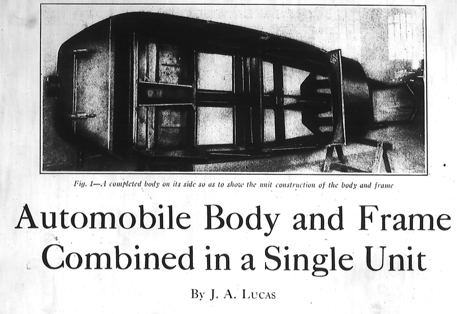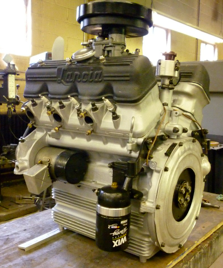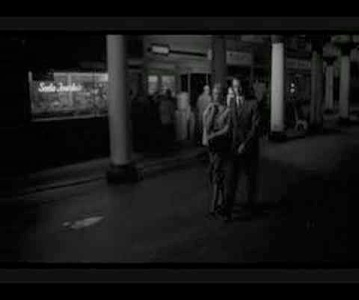Archive for the ‘Aurelia’ Category
Publication – Machinery
fabrication techniques in Turin. They include making of steering boxes, pistons, conrods, blocks, heads, plant organization, building the body frame, etc.
The articles have been scanned from the Library of Congress microfiche, and assembled into a modest printed volume. Also included are some other interesting articles – on Lancia’s V12s of 1917 and 1919 and an extensive report on the 1931 Dilambda.
The volume can be bought either in print or PDF at:
(the booklet is titled Lancia Machinery, but is listed as Lancia Reprints.)

Engine Ready
Here is the engine for the B20 ready to go back in the car. The engine has been run on the bench, gone through several heat/cool cycles, retorqued head, and ready to go.
Walt Spak (<email>) was the engine rebuilder, and he has made a special oil filter adapter to allow a spinoff filter to be used on the car. The original mounting is still used, and the revision can be easily reversed and put back to original. We discussed this at length, and decided that engine longevity (and practically not visible) would be a higher priority. This will allow for quick and complete filter changes. It also was a modification thought appropriate in the change to a higher capacity oil pump along with the change to shell bearings for the mains and the new conrods.



Bugattis on the farm
This New York Times Article on the Bugattis tells of their rescue from a farm in southern Illinois some fifty years ago. Its a great story – one of how an eccentric farmer and an eccentric industrialist met over the group purchase of some 30 Bugattis. Imagine them, in the barns on dirt floors. Needless to say, this was not a transaction done in haste – these two men took some time to find some common ground. The story is told again just the other day in the New York Times, and with all due respect, is repeated below.
For those of you with long memories, there is the story of how Shakespeare and his Aurelia B20. He bought a wrecked B24 Spider out of Indianapolis, and tried to upgrade his green two-tone B20 with a supposedly hotter motor (thus a B20 with a spider motor in it).
The B20 was for sale at Bill Knauz’s in the Chicago area, in the early 1980’s (where I last saw it) and was sold out east again about 5 years ago. It had an original leather interior as mentioned on this site (see photos under History).
The chronicler of this Bugatti event was Bob Shaw, known to us in the Chicago area – a very nice guy and a man who has been active in the car world for some time.
This story is told in greater detail in Automobile Quarterly, vol 34 no 3, which also has a history of De Virgilio and the Lancia V-6.

Engine numbering
view of A on firewall, handwritten on a Katzman spider.
Lancia numbering systems are a study in themselves. Consider the numbers on the Aurelia engine – the motor number is stamped on the block – sequentialLY (to motor production, not cars). Sometimes one finds an “A” stamped on the B24 block for Spider America, with its detuned, torquey cam. Matching the motor number to the car remains an arcane bit of Lancia knowledge only found after decades of experience.
The numbers on the head are most fun. There are several, and include:
casting number – B-1101A, for example
date of manufacture (Jan-53) small stamping
series number (roman numeral I-VI, not sure if this conforms to the series of the car….)
motor number (stamped on the ends)
The oddities are also the amusing part – Steve Katzman has sent in pictures of a B24 block with the number written on the block, in blue pencil (shown above). Never seen that before. He also found an “A” written on the firewall, although the shot isn’t exactly conclusive….
Inside the engine, many parts are stamped or have numbers cast in. The radiator Y is most notorious, listing B20 or B24, or even Nardi’s name when he cast them. I think these are consistent, but there may be variations in them as well.
Major machined parts are stamped: conrods are matched and stamped to each other and to the motor, as are main bearing caps. Water pumps have model numbers cast in their casing, but since the pump could be used in different models, a visit to the parts book is required to determine the right one for the motor.
The historian looks for dates along with the stamps – and the heads are one of the best places to look. The engine blocks came in a number of different castings (last count was 6 different ones), anyone know if they are stamped anywhere?

A touch of evil
Touch of Evil Opening Shot – YouTube
It starts with a car shot….. and ends with a bang. Its the most famous opening shot by Orson Welles, unrivaled for its ability to be close and far, to go 4 minutes without a cut, from outside to inside, above and around buildings in the town, for a walk down the street … until the conclusion. Its a great shot practically unrivaled for its great sequencing.
So you can tell, its winter time, and the cars asleep. Its time for web sites we like. A few others:
The AUTOSPORT Bulletin Board Nostalgia Forum
Targa Florio 1953 or Targa Florio 1953 Lancia
Motor running
Yesterday, Walt called to let me know that he had started the motor. Turned over 1 1/2 times and then ran smoothly. Just lovely.
Engine Rebuild.
The test running setup is more effective than elegant – but it does the trick and is going to be done right: 6 cycles of warming up and running at length before retorqueing the heads. Then put in the car.
Motor coming along – December, 2009
Its started to snow here, so we are socked in for a while. The motor for the B20 is still coming together – but it takes time. Eight months since work started on it… . Walt (in Pittsburgh) continues to plug away, and when the wrenches go down, photos emerge. Of course, better work than photograph, right? The heads are on, the valves in, the bottom is buttoned up, progress.
On the left the inside of a combustion chamber in the cylinder head. Its fun to see that Lancia numbered the cylinders – given that once the heads are on, there aren’t a lot fo choices. One wonders who they numbered them for – the assemblers? Later mechanical work? Or just craftsmanship taken to a funny place?

lower end
The bottom end of the motor is going together. The degree wheel for timing the cam is on the right and the clean block (with its nice red insides) is evident.
Its fun to see the block and all the casting shapes. Work is being done by Walt Spak in Pittsburgh, long time owner of the s. 2 (from about 1975 to 2005), so he’s happy to fiddle with the engine. Walt has built many Aurelia engines over the years, and has an Aurelia and Fulvia himself.
Note the casting date for the block as Feb of 1952, and above, the clean crank, now balanced for the new rods.

Connecting rods for the early 2 liter motors
Now the machining of the block is done, and the lower end is going together. More pictures soon.
The new rod is a bit heavier than the older one, but without the bronze shell insert of the old one, they actually weigh out about the same. As the weight at the wrist pin (gudgeon?) is a bit more with the new rod, the reciprocating weight is higher, and a bit of crank rebalancing was needed. Nothing major.
There has been some progress on the rebuild of the s. 2 motor. The conrods have been made, and they can now be fitted with shell bearings. The new and old one are shown.
Motor rebuild progress
Connecting Rods



the old rod is on top. Note the bronze insert in the old rod.
Guzzi Museum
The museum is located in Mandello del Lario, on Lake Como, at the factory. It has practically one of every bike they made, and more importantly, the famous racing bikes – including the 4 cyl and V8 500 cc GP bikes of 1955. Amazing variety and history to be found.
Guzzi Gallery. The images are a bit rough, scanned from old negs, with dust, to remind you of the simple settings and light of the way museums used to be.
Best to call for hours before going. When I went, it was open every day but only at 3 PM! its well worth a visit. Patrick Bedard did a wonderful Cycle article on this museum as “The Racer as Tourist” in the 1980’s, and captured its remarkable aura. There was a 500 cc V8 motor on display, along with the bike it was in. 1955 was a good year.A memorable experience to be sure.


There are more shots here: Guzzi Museum
